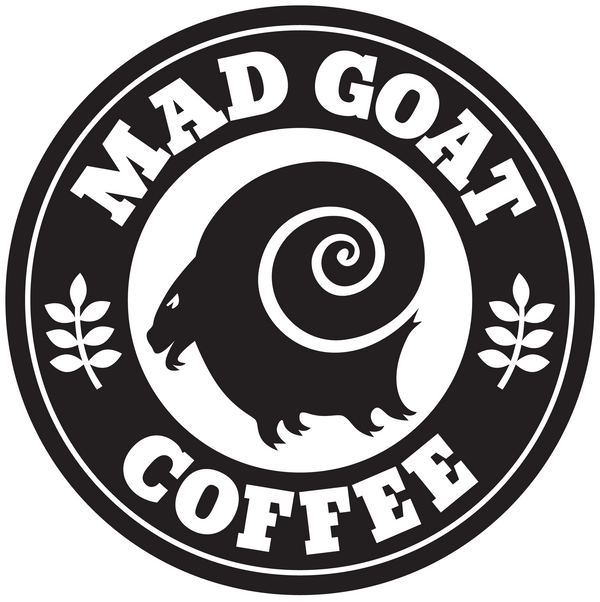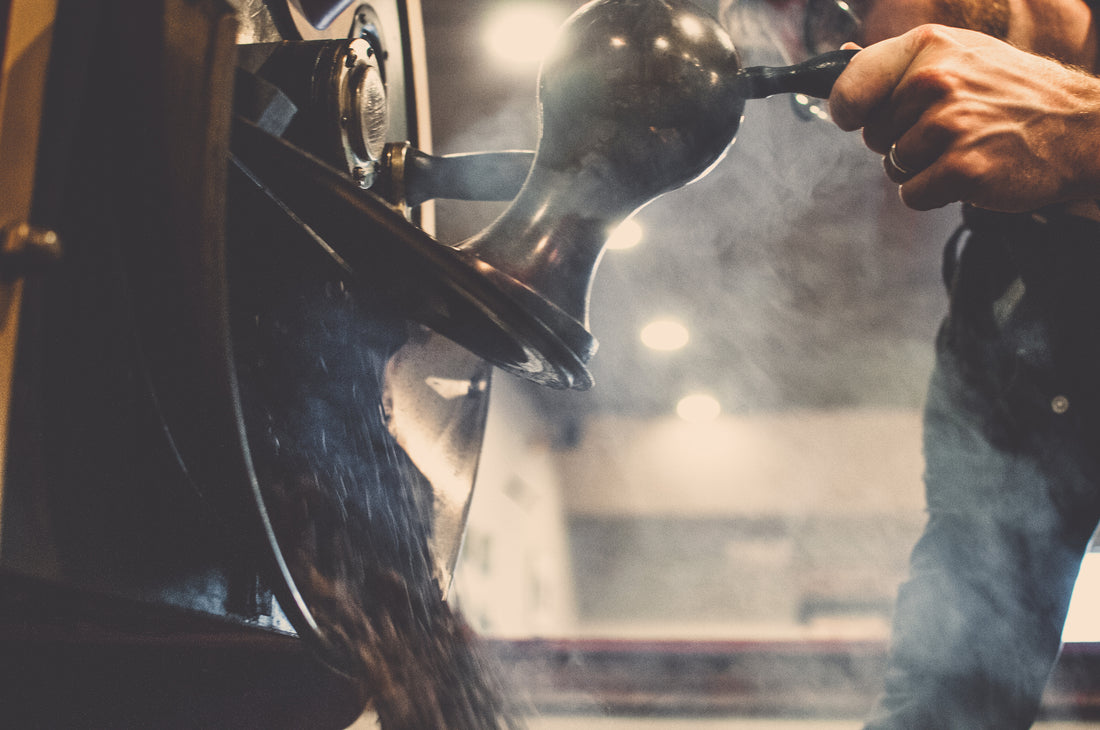
Coffee roasting is enjoying a heyday almost like never before in the history of coffee. Industry publications contain headlines every week of new roasters opening up, new roasting philosophies being trotted out, brewing technologies under development, and scientific research shedding light on what was once a dark art. In short, there has probably never been a better time to be a coffee junkie!
But what exactly is coffee roasting, and what does it do? Why does it seem that there's as many coffee roasters nowadays as there are craft breweries, and do we really need those kinds of options? Don't you just roast coffee until it's brown and call it a day?
In this edition of Mad Goat University, we'll try to explain roasting in as simple terms as possible to help you understand and articulate the most important part of roasting: the way it impacts the flavor of the coffee we all love so much. We'll also outline our roasting philosophy and how it might be different from other places. Let's get to it!
Wanna roast coffee? Study chemistry.
The simplest way to explain roasting is that it's a chemical reaction. Actually, it's hundreds of individual chemical reactions that take place simultaneously in coffee seeds as heat is applied to them. However, all of those can get complicated even for roasters. So it's just as easy to say it's a chemical reaction, akin to cooking.
Just like in cooking, good roasters follow a recipe. They do this both to know what to expect in a finished product and to be able to reproduce a good recipe again and again in the future. For coffee roasters, our recipes are called "profiles." A profile is just a name we've given to a line graph (of varying complexity) that, at it's simplest, shows the rate at which coffee beans heat up in the roaster over time. Traditionally, these graphs have been done on paper (or mentally), but most roasters now utilize some kind of computerized logging software, attached to one or more temperature probes, for this purpose. Mad Goat is no different in this regard.
The cooking analogy is actually a great one, because the exact same reactions that occur when cooking food occur when roasting coffee. The reaction that you use to char a steak on the grill to seal in the juices is the same one that turns a coffee seed brown during the roasting process. Many of the same compounds present in the raw foods we cook are also present in raw green coffee, and they metabolize the same way under applied heat. Just like a master chef can be said to be an expert in applying heat to food, so too a roaster is really just a conduit for controlling the heat applied to a coffee and the rate at which the coffee is allowed to heat up. Too little heat and a roaster can "bake" a coffee. Too much and the coffee can burn, usually by roasting defects called "scorching" and "tipping."
Stages of the roast
Coffee roasting has 3, and perhaps 4, clear stages that each roast progresses through. It is the roaster's job to see that every batch progresses the way that it needs to through each stage so that the end result is a high-quality and reproducible flavor experience.
However at the beginning, coffee is just a raw, green seed. Useless as is (unless you want to start a coffee farm), virtually odorless, and ranging in color from yellowish to deep green, green coffee usually has the subtle aroma of wet grass. Sometimes, depending on the processing method, this aroma can be fruity and fermented, but always pales in comparison to the finished product.
Raw coffee seeds are deposited into a properly warmed roaster in what's called a "charge." The amount of coffee used in the charge and the beginning temperature of the roaster - called "charge temp" - are both crucially important in the resulting roast. During the first 1-2 minutes of the roast, the coffee heats up rapidly from room temperature until it reaches an equilibrium point with the air temperature of the roaster. This is called the "turning point" or "turnaround." This can be thought of as the launching point for the entirety of the roast.
Drying
The first 6-ish minutes of a roast are commonly called the "Drying Phase." This phase has little real impact on the final cup flavor, although it is important to progress through it within certain parameters. Drying is exactly what it sounds like: the water moisture trapped in the raw coffee seeds is expelled as the internal temperature of the seeds continues to rise. As this happens, the coffee will go from it's initial green hue to a yellowish brown, and the aroma will change from that of wet grass to that of hay, straw, or bread. Once the green coffee is fully yellow and the aroma changes, drying is over and the real roasting begins. This generally happens around 300F, depending on the roaster and probe placements.
Pre-First Crack, Ramp, or No Name Phase
Traditionally the phase of a roast that happens from about 6 minutes up until First Crack hasn't garnered much attention. In fact it didn't really have a name for a long time, and still doesn't really have an agreed upon label. However, that lack of attention has been changing over the last several years as more scientific information comes to light about what exactly is happening during this phase. The short summary is, a lot. A lot is going on here.
During this phase, the coffee will go from yellow to brown. A color change like this is a clear indication that chemical reactions are taking place, and boy are they! Long-chain carbohydrates are metabolizing into shorter chain sugars, acids, and other such molecules. It's these reactions that start to impact the cup flavor of coffee.
The most important reaction to know is the Maillard Reaction. We won't go into to much detail on it here, but it's this reaction that's responsible for the browning of coffee and the charring of meat. As this reaction progresses, sugars begin to caramelize. Organic acids form and re-form. If left to progress, ultimately the coffee will end up a flavorless, blackened husk of pure carbon - better known as charcoal.
Progression through this phase is the point at which the roaster really begins to exert some influence on the final product, and every roaster has a different philosophy. At Mad Goat, our goal is well-defined body (mouthfeel) and balanced sweetness.
Post-First Crack, or Development Phase
This phase is simply the stage of the roast from First Crack to the end, or "drop." However to explain it, we should probably briefly touch upon the phenomena of First Crack.
First Crack
Traditionally, First Crack (1C) has been known as the point when the roasting really begins and so the phase marked by it's emergence has been known as Development. However, that's been shown to be misleading. Development really takes place along the whole profile, and 1C is truly just an event that happens along the profile. An important event, no doubt, as it is an audible waypoint during the roast. However, roasting doesn't begin with 1C.
So what exactly is 1C? 1C is simply the point where the pressures that have been building inside the coffee seeds from the multitude of reactions taking place within them finally overwhelm the cellulose framework of the seed, fracturing it in in a rapid outgassing and causing an audible "POP!" Actually, hundreds of them, and it sounds similar to popcorn. This usually happens around 390-ish degrees F, again depending on the roaster.
After 1C
During this last phase of the roast is when you may notice a roaster being the most active. This is because it is critical to manage the heat in the roaster so as to prevent the roast from progressing too quickly, or from progressing too slowly, or from stalling altogether. All of which negatively impact cup flavor. Because of the chemical reactions taking place, the heat in the roaster becomes hard to manage because the coffee itself will begin to consume or exhale heat in ways that make it difficult. This is the chief advantage of computer logging software. The same coffee will generally behave similarly in the roaster, so by following a previous roast a roaster knows what to expect and when, and so can manage heat more effectively.
What is true about this phase, and is probably why "Development" has been such a sticky label, is that this is where a roaster can produce either a "light" or "dark" roast. This depends on the ending "drop temperature" and either the total roast time, or more commonly the time from 1C. This is because as the coffee progresses through the phase, sugars further caramelize and eventually begin burn-off, leaving behind carbon. This produces a noticeable smoky flavor in the cup, and is a clear indication of a darker roast. The volatile coffee oils in the roasted seeds will also start to appear on the surface of the beans, where they quickly begin to evaporate (taking coffee flavor with them). A light roast, in contrast, has a dry bean surface and perhaps a ridged texture. In the cup, light roasts are usually brighter, more acidic, and more fruity than darker roasts, which range into nutty, chocolaty, or smoky flavors.
At Mad Goat, our roasts range from light to medium-dark, what's known in roasting terminology as "city" to "full city+". We feel that this gives our coffee the balance between acidity, sweetness, and body that we desire.
Second Crack and Beyond
If allowed to continue, a roast will quiet after 1C and eventually Second Crack will begin. 2C sounds much more like a crackle, like Rice Crispies, than the popcorn POP of 1C. However, at Mad Goat the darkest roast we produce edges right up to the first few snaps of 2C before being dropped (we do occasionally produce something even darker for a few fans who like this flavor, but it's generally upon request).
Fire
Although we've never personally heard it, there is allegedly a Third Crack even later that occurs just prior to combustion. Yes, you read that right: combustion. If allowed to progress too far a roast will eventually burst into flames! However, when roasting to the degree that Mad Goat does this is a very small possibility (and is usually the result of dirty roaster ductwork). So, hopefully no worries!
Once a coffee is done roasting, it must cool quickly. Then, it's best for a coffee to rest for a day or two to allow excess carbon dioxide to escape from the freshly roasted bean. At this point, the coffee is at peak freshness for about a week to 10 days. At about a month, a coffee is still considered fresh, but the quality does degrade every day until the coffee is bland and stale.
Now that you understand the roasting process, stick with us for future articles about roasting schools or philosophies, and many more coffee related topics. By the time we're done, everyone will be an expert!

